Movie Toast with Morning Tea ~ 1936
The number of films released during the year 1936 dropped to 134 from 154 in the previous year 1935.
Most of the old online studios like East India Film Company, Imperial, Kolhapur Cinetone, Madan, Saroj, Sharda were finding their way gradually to the annals of history on Indian Cinema. Probably, they were unable to sustain the audience interest with their kind of films and had to give way to the more socially relevant and / or thematically interesting films! In terms of number, Imperial and Madan had an impressive eight to ten releases each, but in spite of their ‘pioneering works’, their films left much to be desired.
Studios like Bombay Talkies, New Theatres, Prabhat, Sagar experimented and established and / or reinvented and resurrected themselves with different, unconventional and contemporary subjects. They created their own brands of film making and went on to become role models for their successors.
Some of the noteworthy flms of the year were: “Achhut Kanya” (Bombay Talkies), “Amar Jyoti” (Prabhat), “Bambai Ki Billi” (Imperial), “Deccan Queen” and “Manmohan” (Sagar) and “Manzil” (New Theatres), a fair mix of the seminal and social, spectacular and stunt and, never the least, successful. Of these, “Amar Jyoti”, “Bambai Ki Billi” and “Deccan Queen” as also “Lagna Bandhan” had something common running through them i.e. the ‘lost and found’ thread. Interestingly, the sub plot of the very first talkie film “Alam Ara” released in 1931 was based on the underpinning of ‘lost and found’ and it set a successful trend. Filmmakers down the years are reveling in the art and craft of losing and finding themselves in a newer light.
Bombay Talkies
Himanshu Rai’s newly established studio released three films of varied themes: “Achhut Kanya”, “Janmabhoomi” and “Jeevan Naiyya”; all the three presented a new actor named ‘Kumudlal Kunjalal Ganguli’ opposite Rai’s actress-wife Devika Rani.
Kumudlal started as a lab assistant with the studio. By a quirk of circumstances, a nervous, reluctant and shy Kumudlal was forced to don the grease paint and face the camera despite a screen test which failed him because of his ‘girlish features and a broad jaw line’. Destiny had clearly written the arrival of a new actor, the adulation that he was to enjoy as a star, the accolades and awards that he were to win and the legendary status that he was to be accorded. The same nervous and shy Kumudlal went on to become the legendary actor Ashok Kumar who regaled the audience for over five decades.
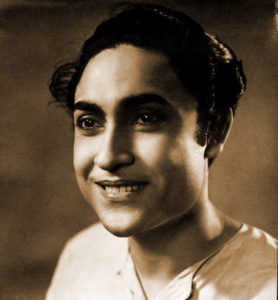 Ashok Kumar made his debut as a lead actor in “Jeevan Naiyya”, a sensitive film about social ostracism of dancing girls. The film was a moderate success and was followed by two more socially relevant films: “Achhut Kanya” and “Janmabhoomi”. All the three films paired him opposite Devika Rani. As a popular lead pair, they acted together in about eight films of Bombay Talkies.
Ashok Kumar made his debut as a lead actor in “Jeevan Naiyya”, a sensitive film about social ostracism of dancing girls. The film was a moderate success and was followed by two more socially relevant films: “Achhut Kanya” and “Janmabhoomi”. All the three films paired him opposite Devika Rani. As a popular lead pair, they acted together in about eight films of Bombay Talkies.
The innocuous and innocent “Achhut Kanya” was a hard hitting comment on the caste system and social inequalities but layered with impassioned lyricism and romanticism. Ashok Kumar and Devika Rani played the star crossed lovers nursing silently the wounds of their unrequited love; he played the upper crust Brahmin boy and she, an ‘untouchable’ girl. The film came in the wake of Gandhiji’s protest against the isolation and segregation of the ‘untouchables’ and went on to become the biggest hit of the year. The film shot Ashok Kumar to instant stardom and after that, there was no looking back for the actor. For more details on the five decade long fascinating journey of the thespian, click link: The Timeless Travelogue of the Ageless Ashok Kumar.
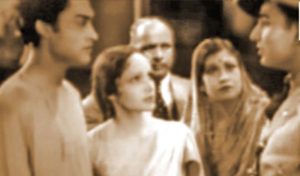 “Janmabhoomi”, as the title suggests, could be termed as a patriotic film and the first of its kind. The film was about a selfless doctor renouncing all material pleasures including his love and dedicating himself to the needy in a remote village. This nobility and sacrifice was used metaphorically as serving the country and hence the patriotic tag. The film also depicts class conflict which gets transmuted eventually to class collaboration.
“Janmabhoomi”, as the title suggests, could be termed as a patriotic film and the first of its kind. The film was about a selfless doctor renouncing all material pleasures including his love and dedicating himself to the needy in a remote village. This nobility and sacrifice was used metaphorically as serving the country and hence the patriotic tag. The film also depicts class conflict which gets transmuted eventually to class collaboration.
These films were directed by Franz Osten and music was given by Saraswati Devi. “Janmabhoomi” was the first film to have an explicitly worded nationalistic song Jai jai janani janmabhoomi filmed on Chandraprabha and sung by her composer-sister Saraswati Devi.
There was no playback then and the actors had to willy-nilly sing their songs. In his debut film, Ashok Kumar sang Koyi hamdam na raha which was later used note to note by his multi talented younger brother Kishore Kumar in his film “Jhumroo” (1961). The most popular song of the year was the 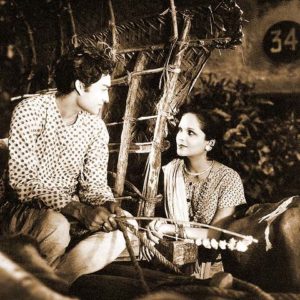 timeless romantic duet Main bann ki chidiya banke bann bann dolun re sung by Ashok Kumar and Devika Rani for the film “Achhut Kanya”. Saraswati Devi, it is believed, had a harrowing time recording the song in the untrained voices of the lead actors. She rehearsed the actors for twelve hours everyday for about a week and then recorded the song. In the final recording, she kept their vocals to the minimum and embellished the song with long interlude music.
timeless romantic duet Main bann ki chidiya banke bann bann dolun re sung by Ashok Kumar and Devika Rani for the film “Achhut Kanya”. Saraswati Devi, it is believed, had a harrowing time recording the song in the untrained voices of the lead actors. She rehearsed the actors for twelve hours everyday for about a week and then recorded the song. In the final recording, she kept their vocals to the minimum and embellished the song with long interlude music.
All the songs were written by J S Cassyap ‘Natawan’. The lyrics of the ‘chidiya-panchhi‘ dulcet duet, on a casual hearing, may sound juvenile. But, on a spiritual note, they connote subtly the dream of the ‘untouchable’ character to break free; to break free from the ‘bondage of untouchability’ and belong to another world free of the caste and creed discrimination and be ‘touched’ by the warm feelings of acceptance and love. At a personal level, the lyrics are reflective of the off screen liberated persona of Devika Rani.
Bombay Talkies experimented and released two films titled “Mamta” and “Miya Biwi” with two different star cast as ‘one film’. However, it was “Achhut Kanya” that gave ‘status and standing’ to Bombay Talkies and the lead pair.
New Theatres
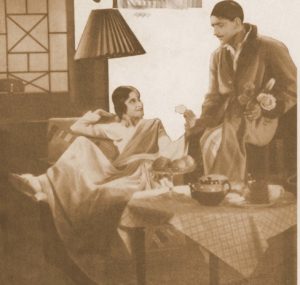 New Theatres had three releases: “Manzil”, “Maya” and “Millionaire” (or “Karodpati”). “Manzil” was based on a sensitive story Grihadaha by Saratchandra Chatterjee on human relationships between three people belonging to different strata of the contemporary society. The film revolves around two friends (Prithviraj Kapoor and Pahadi Sanyal) and their disoriented emotions and feelings for the girl (Jamuna) they both love. The film was directed by P C Barua and, as in Devdas, he finds a solution to their dilemma in the form of death of the guilty friend; death, incidentally, was a leitmotif in most of Barua’s films marked by doom and despair.
New Theatres had three releases: “Manzil”, “Maya” and “Millionaire” (or “Karodpati”). “Manzil” was based on a sensitive story Grihadaha by Saratchandra Chatterjee on human relationships between three people belonging to different strata of the contemporary society. The film revolves around two friends (Prithviraj Kapoor and Pahadi Sanyal) and their disoriented emotions and feelings for the girl (Jamuna) they both love. The film was directed by P C Barua and, as in Devdas, he finds a solution to their dilemma in the form of death of the guilty friend; death, incidentally, was a leitmotif in most of Barua’s films marked by doom and despair.
A crucial part of the film is reminiscent of a real life incident that took place in and around the same year. As is well known, the liberated Devika Rani (actress-wife of Himanshu Rai) and her co star Najam ul Husain eloped during the shooting of “Jeevan Naiyya” and were traced back. On her return, she was forgiven and accepted again by a restrained Rai. “Manzil” too had a similar track of the staid and serious minded husband forgiving his errant and liberated wife and accepting her. The similarity ends there!
R C Boral and Pankaj Mullick composed music for the film. Renowned Urdu poet Arzoo Lucknowi made his debut as a lyricist. The song Sundar naari preetam pyaari, written in chaste Hindi and sung by Pankaj Mullick, can be credited as the first Hindi film song in praise of beauty.
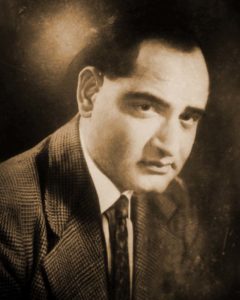 “Millionaire” (or “Karodpati”) was a complete deviation for both New Theatres as well as K L Saigal from the usual serious, sensitive and seminal films they are associated with. The film, the first of its kind, was set in the backdrop of the film world and is about a crazy movie buff played by Saigal. He suddenly wins a jackpot and wants to enter the glamour world. The film takes several twists and turns leading from one hilarious situation to another.
“Millionaire” (or “Karodpati”) was a complete deviation for both New Theatres as well as K L Saigal from the usual serious, sensitive and seminal films they are associated with. The film, the first of its kind, was set in the backdrop of the film world and is about a crazy movie buff played by Saigal. He suddenly wins a jackpot and wants to enter the glamour world. The film takes several twists and turns leading from one hilarious situation to another.
Music was by R C Boral and lyrics by Kidar Sharma. Saigal sang the fun song set in qawali style Jo naukri dilaade B A banaanewale along with Pahadi Sanyal. In another song, Kidar Sharma parodied Dr Iqbal’s famous philosophical and spiritual rhapsody Kabhi ae haqeeqat-e-muntazir, nazar aa libaas-e-majaaz mein (beseeching the long and eagerly awaited Absolute Truth to appear and manifest in the human form). He replaced Iqbal’s words ‘muntazir‘ and ‘majaaz‘ with his amusing lyrics which went Kabhi ae haqeeqat-e-rasbhari, nazar aa libaas-e-sharaab mein (imploring the eagerly awaited well endowed beloved to appear in an intoxicating form).
The third and the lesser known film was “Maya” with Jamuna, Pahadi Sanyal and Azurie in the lead. The film had a sub plot of the ‘unwed mother’ though the film was not about the sensitive issue. Again, it was directed by Barua with music by R C Boral and Pankaj Mullick.
During the year, New Theatres presented a socially relevant film of International Film Art Productions titled “Pujarin”. It was a remake of New Theatres’ Bengali film “Dena Paona”. Based on a story by Saratchandra Chatterjee, the film depicted the evils of the dowry system and exploitation of women in the 19th century Bengal. K L Saigal was the hero of the film and the song Jo beet chuki so beet chuki sung by him became very popular.
Prabhat
“Amar Jyoti” was a socially relevant film directed by V Shantaram. The film focussed on the issue of societal discrimination and inequality towards women in the male dominated society. Set in an imaginary seaport kingdom, this adventurous costume drama presented Durga Khote as a wronged woman denied custody of her own son as per the prevailing patriarchal system. To vindicate the injustice meted to her, she turns into a rebellious pirate, protests against the system, takes revenge on the wrong doers and fights for her rights ultimately leading to a revolution.
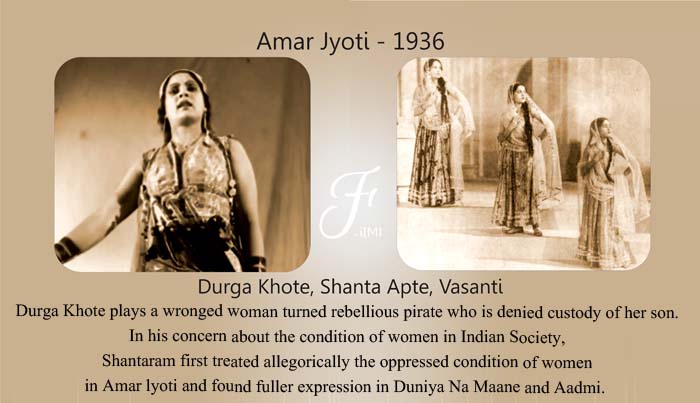
Durga Khote is supported in her daredevil exploits and dauntless mission by Vasanti (her trusted advisor’s little daughter and aide) and Shanta Apte (a young princess held in captive by Durga Khote and in love with a poor shepherd played by Nandrekar). Khote brings about a transformation in Apte and her ideologies on love and relationship and stresses on the need to crusade for her identity and equality. Incidentally, the shepherd she loves turns out to be the long lost son of Durga Khote.
Durga Khote ignites the screen with a resplendent performance having multi layer dimensions to her role: as a pirate seething in anger and seeking revenge, as a mother sobbing in silence for her lost son and suppressing her emotions in the interface with him and, finally, as a woman rebelling at one level for her individual rights to equality and social status, and on another level, rising above the self for a revolution by handing over the legacy to Shanta Apte.
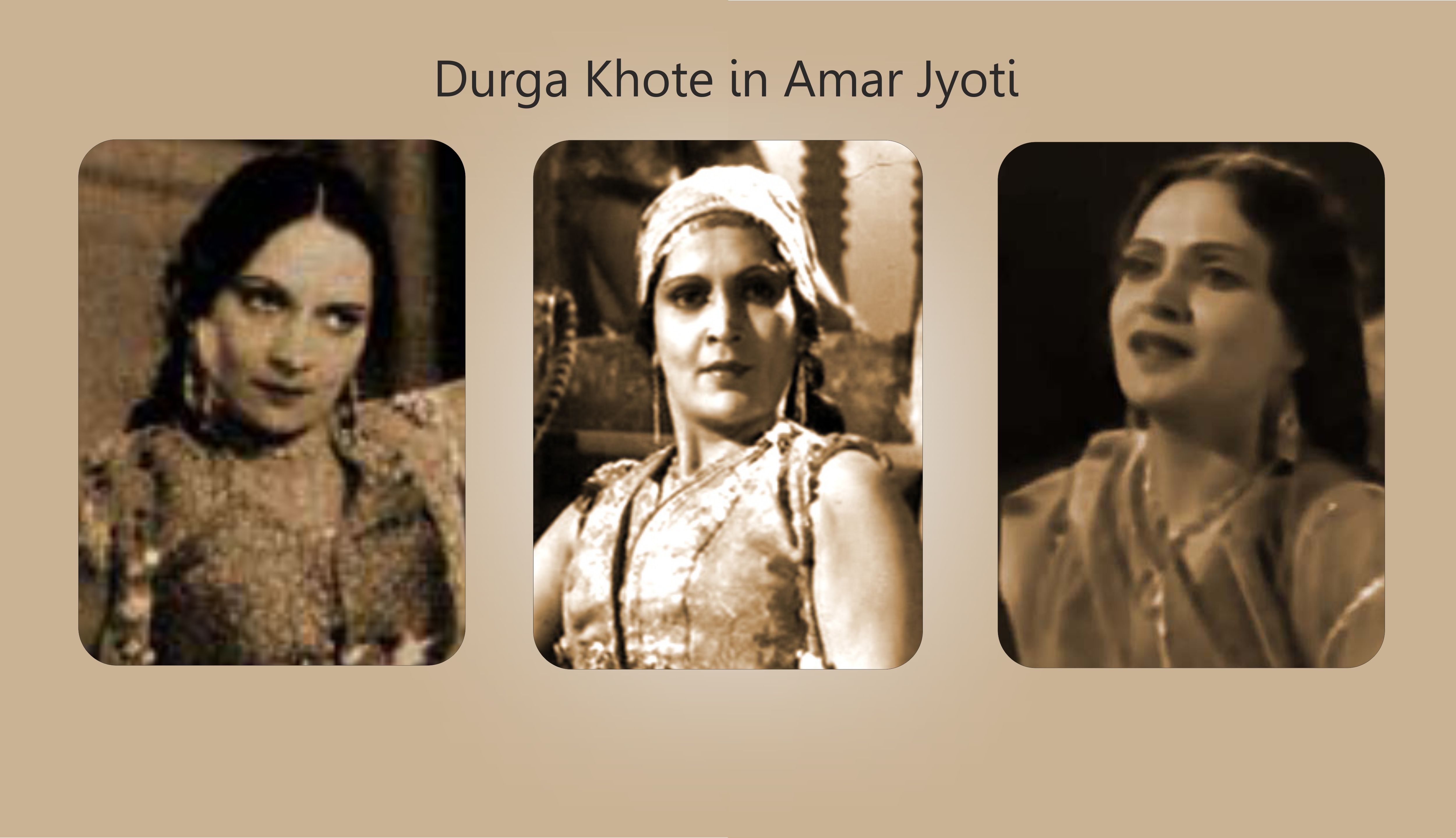
The film’s climax avoids the clichéd reunion and rejoicing; instead, “Amar Jyoti” lights up a neo-realist climax. In the mother-son interface, the mother comes to know the identity of her lost son and is ‘united’ with him emotionally but disallows her identity to be disclosed the other way around. The truism being not to allow the son to be shocked and stunned from the picture of idealism and nobility that he has painted of his mother!
“Amar Jyoti” was the first Indian film to be screened at the Venice International Film Festival. Thematically, technically and tunefully, the film was noteworthy; the scenes of the surging waves striking against the solid rocks (symbolic of the subservient challenging the strong), ships ablaze on high seas, the swashbuckling spectacles, spirited pirates seizing and subjugating the people in power.
The film had music by Master Krishnarao and had the popular song Suno suno he bann ke praani sung by Shanta Apte. The song, written by Pandit Narottam Vyas, uses a wild imagination and allegory exhorting the shrubs, stones and spiny structures of the jungle to assume ministerial tasks! Yet another song that became popular was Aaj hamen bann behad bhaata sung by Shanta Apte and Nandrekar.
The film was a big hit inspiring Shantaram to focus on more serious issues relating to women in films like “Duniya Na Maane” and “Aadmi”.
Imperial Films
From among the nine releases of Imperial, the most talked about film was “Bambai Ki Billi”. It was a remake of the company’s silent film “Wildcat of Bombay” (1927) starring Sulochana aka Ruby Myers in the title role. For Myers it was a challenge replicated; she played a role modelled on Robin Hood looting the rich and helping the needy and poor. And, in her daring adventure, she portrayed with great relish as many as eight characters: a policeman, a Hyderabadi gentleman, a medical student, a gardener, a fruit vendor, a street urchin, a European lady to name a few to outwit the police and entertain the audience. Needless to mention, the film was a wild hit.
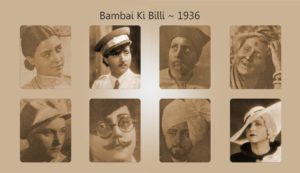
“Bambai Ki Billi” too had the ‘lost and found’ angle to it. The much wanted Wildcat on the run turns out to be the long lost daughter of a Judge; she is kidnapped when young by a notorious gangster who then blackmails the Judge to acquit him from a murder charge. She grows up to become a Wildcat on the prowl for her prey and takes revenge appearing in different disguises.
It is stated that Ruby Myers commanded a princely salary of Rs. 5,000 per month (more than the salary of the then Governor of Bombay). She flaunted her well sculpted figure in chiffon sarees and sleeveless blouses and moved around in a Chevrolet. In fact, she was a fashion icon, an epitome of glamour and grace, sensuality and style and her films redefined entertainment and demonstrated an excitement unheard of before.
In the film, Ruby Myers was cast opposite the hugely popular D Billimoria of the silent era and the two were paired romantically in a number of hit films till almost the end of the decade.
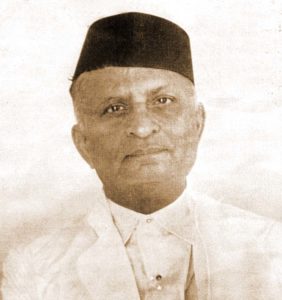 The film was directed by Nandlal Jaswantlal who is remembered today for his two super hit films: Filmistan’s “Anarkali” (1953) and “Nagin” (1953). Incidentally, Ruby Myers was a part of Filmistan’s “Anarkali” and played the role of Jodha (wife of Akbar). It would also be interesting to note that she essayed the role of Anarkali in the silent film made by the same name in 1928 and again in the talkie version of the same film in 1935.
The film was directed by Nandlal Jaswantlal who is remembered today for his two super hit films: Filmistan’s “Anarkali” (1953) and “Nagin” (1953). Incidentally, Ruby Myers was a part of Filmistan’s “Anarkali” and played the role of Jodha (wife of Akbar). It would also be interesting to note that she essayed the role of Anarkali in the silent film made by the same name in 1928 and again in the talkie version of the same film in 1935.
Sagar
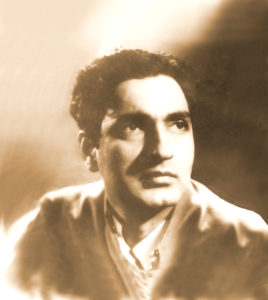 Sagar had a couple of good releases during the year but the two noteworthy hits were: “Deccan Queen” and “Manmohan”. “Deccan Queen” marked the debut film of Surendra as an actor-singer and the film’s credits flashed his name as ‘Surendranath B A, L L B’. The film was directed by Mehboob, his second directorial venture following the success of his debut film “Judgement of Allah” and had music by Pransukh Nayak.
Sagar had a couple of good releases during the year but the two noteworthy hits were: “Deccan Queen” and “Manmohan”. “Deccan Queen” marked the debut film of Surendra as an actor-singer and the film’s credits flashed his name as ‘Surendranath B A, L L B’. The film was directed by Mehboob, his second directorial venture following the success of his debut film “Judgement of Allah” and had music by Pransukh Nayak.
The Bombay based Sagar presented Surendra as an answer to the Calcutta based New Theatres’ Saigal. Even the song Birha ki aag lagi more mann mein sung by Surendra was on the mould of Saigal’s Baalam aaye baso more mann mein from “Devdas”. It was Anil Biswas who helped Surendra come out of the Saigal syndrome and create a distinct identity for himself.
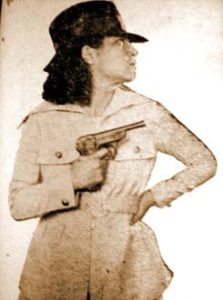 The story, screenplay, dialogues and songs were written by Zia Sarhadi, then a relatively less known writer with Marxist ideologies. “Deccan Queen” was the first film to have the heroine in a double role. Aruna Devi played the role of a sober and simple typist girl in love with a Police Inspector (Surendra) and also that of the dreaded and wanted ‘Deccan Queen’ out to take revenge on her cheaters and wrong doers. The eponymous ‘Deccan Queen’ was used for the heroine to show her speed and swiftness to elude and outwit the police and law makers!
The story, screenplay, dialogues and songs were written by Zia Sarhadi, then a relatively less known writer with Marxist ideologies. “Deccan Queen” was the first film to have the heroine in a double role. Aruna Devi played the role of a sober and simple typist girl in love with a Police Inspector (Surendra) and also that of the dreaded and wanted ‘Deccan Queen’ out to take revenge on her cheaters and wrong doers. The eponymous ‘Deccan Queen’ was used for the heroine to show her speed and swiftness to elude and outwit the police and law makers!
The film’s story says that a brother and sister (who grows up to be the ‘Deccan Queen’) are separated in their childhood by people ‘trusted’ and ‘close’ to the family for their own benefits. As the narrative unfolds, we see a simple and sober look alike of the ‘Deccan Queen’ working in a company and in love with the Inspector. But, no where it is mentioned in clear terms that the two are sisters; only their uncanny resemblance to each other leads one to think that they could be long lost sisters.
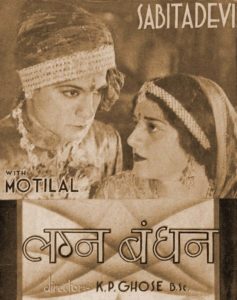 Yet another film of Sagar with the lead actor in a double role and entrapped in the ‘lost and found’ drama was “Lagna Bandhan” (also called Forbidden Love). Motilal played the dual role: one as a drunken and debauched prince and the other as his identical twin kidnapped by his own outlaw uncle when they were young. Again, greed and revenge are the motto behind the kidnap and after several twists and turns, the two brothers are united. Sabita Devi and Azurie provided the romantic interest.
Yet another film of Sagar with the lead actor in a double role and entrapped in the ‘lost and found’ drama was “Lagna Bandhan” (also called Forbidden Love). Motilal played the dual role: one as a drunken and debauched prince and the other as his identical twin kidnapped by his own outlaw uncle when they were young. Again, greed and revenge are the motto behind the kidnap and after several twists and turns, the two brothers are united. Sabita Devi and Azurie provided the romantic interest.
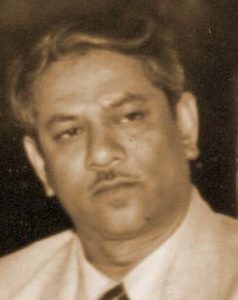 The second major film of Sagar was “Manmohan” which was a bigger hit than the company’s previous film “Deccan Queen”. This film was also directed by Mehboob and the story, screenplay, dialogues and songs were written by Zia Sarhady. “Manmohan” was ‘inspired’ by New Theatres’ “Devdas” and had a similar storyline; in fact, some branded it as a ‘poor man’s “Devdas”‘. But, with Mehboob’s midas touch and showmanship, the film went on to become a massive hit.
The second major film of Sagar was “Manmohan” which was a bigger hit than the company’s previous film “Deccan Queen”. This film was also directed by Mehboob and the story, screenplay, dialogues and songs were written by Zia Sarhady. “Manmohan” was ‘inspired’ by New Theatres’ “Devdas” and had a similar storyline; in fact, some branded it as a ‘poor man’s “Devdas”‘. But, with Mehboob’s midas touch and showmanship, the film went on to become a massive hit.
The film starred Surendra and Bibbo in the lead and had music by Ashok Ghose. The song Tumne mujhko prem sikhaaya sung by the lead pair became immensely popular.
Other films of Sagar released during the year include: “Do Deewane” (starring Motilal and Shobhana Samarth), “Jeevan Lata” (Motilal and Sabita Devi, the popular lead pair of many films) and “Village Girl” (Surendra and Sabita Devi).
The success of “Deccan Queen” and “Manmohan” consolidated the position of Mehboob as a director of great stuff and also put Sagar on a higher pedestal. In the years to come, it was a clear case of the ‘creation’ becoming bigger than the ‘creator’!
Notable Natter ~ 1936
Before making a name for themselves in mythological and musical films, Prakash Pictures dabbled in action and costume dramas. Some of their releases during the year were: “Azaad Veer”, “Passing Show”, “Snehlata” and “Tope Ka Gola”. All the four had Jayant in the lead who had made his debut in 1935 with films of Prakash Pictures.
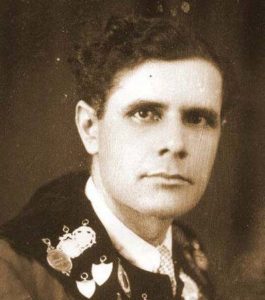 Similarly, before embarking on his historical marvels, Sohrab Modi experimented with one more screen adaptation of Shakespeare’s play. After his directorial debut in 1935 with “Khoon Ka Khoon” (based on Hamlet), Sohrab Modi directed “Sayeed-e-Hawas” based on King John. In fact, the film was a ‘stage recording’ of the play and produced by his Stage Film Company. In the years to come, the company came to be known as Minerva Movietone with a picture of a roaring lion in the emblem symbolising the majestic persona of Modi.
Similarly, before embarking on his historical marvels, Sohrab Modi experimented with one more screen adaptation of Shakespeare’s play. After his directorial debut in 1935 with “Khoon Ka Khoon” (based on Hamlet), Sohrab Modi directed “Sayeed-e-Hawas” based on King John. In fact, the film was a ‘stage recording’ of the play and produced by his Stage Film Company. In the years to come, the company came to be known as Minerva Movietone with a picture of a roaring lion in the emblem symbolising the majestic persona of Modi.
“Sayeed-e-Hawas” marked the debut of G M Durrani as a singer. He sang the song Maston ko aen farz hai peena sharab ka which was also composed by him.
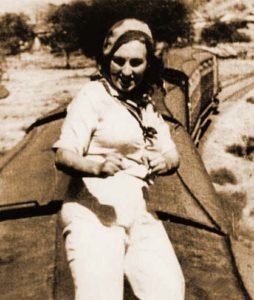 Wadia’s film “Miss Frontier Mail” was the first film to feature a parody song Jao jao ae mere saadho, sabhi bhulaao gham. It is a parody of Jao jao ae mere saadho raho guru ke sang sung by K C Dey in “Pooran Bhagat” (1933). As in other films of Nadia, the highlight of the film was the stunts performed by her on top of a speeding train and fighting single handedly a gang of bandits.
Wadia’s film “Miss Frontier Mail” was the first film to feature a parody song Jao jao ae mere saadho, sabhi bhulaao gham. It is a parody of Jao jao ae mere saadho raho guru ke sang sung by K C Dey in “Pooran Bhagat” (1933). As in other films of Nadia, the highlight of the film was the stunts performed by her on top of a speeding train and fighting single handedly a gang of bandits.
Incidentally, the film’s theme of a masked man wanting to disrupt the railway service of a certain place and make way for an airline service reminds of B R Chopra’s “Naya Daur” (1957) where the city bred Jeevan tries to ‘replace’ the hand driven horse carts (tongas) by machine driven vehicles in the name of industrialisation.
The year marked the debut of 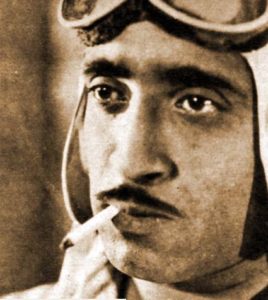 K N Singh (Krishan Niranjan Singh). He was introduced by Prithviraj Kapoor to Debaki Bose who cast him in East India Film Company’s “Sunehra Sansar”. However, his first released film was the action film “Bandit of the Air” in which he played an action hero. Before joining films, he was a sportsman and was exceptionally good in the javelin throw and shot put. He was also selected to represent in the Berlin Olympics in 1936 but destiny had other plans for him.
K N Singh (Krishan Niranjan Singh). He was introduced by Prithviraj Kapoor to Debaki Bose who cast him in East India Film Company’s “Sunehra Sansar”. However, his first released film was the action film “Bandit of the Air” in which he played an action hero. Before joining films, he was a sportsman and was exceptionally good in the javelin throw and shot put. He was also selected to represent in the Berlin Olympics in 1936 but destiny had other plans for him.
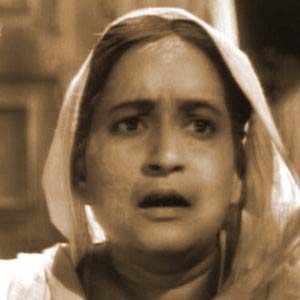 Leela Mishra made her debut in Kolhapur Cinetone’s film “Honhaar” which was directed by Gajanan Jagirdar. She was cast opposite Shahu Modak but as she refused to embrace or touch the hero, she lost the role of heroine. Instead, in the same film, she played mother to Modak and the film paved way for her to play the eternal ‘mother’ or mausi’ from the young age of 28!
Leela Mishra made her debut in Kolhapur Cinetone’s film “Honhaar” which was directed by Gajanan Jagirdar. She was cast opposite Shahu Modak but as she refused to embrace or touch the hero, she lost the role of heroine. Instead, in the same film, she played mother to Modak and the film paved way for her to play the eternal ‘mother’ or mausi’ from the young age of 28!
P L Santoshi, father of today’s renowned director Rajkumar Santoshi, made his debut as a lyricist with an eminently forgettable film “Vish Vaman”.
Legends born during the year include popular names like Gulzar (writer-filmmaker), Manmohan Desai (filmmaker), Mala Sinha, Nutan and Vyjayantimala (actresses).
The year witnessed a mix of seminal and social films like “Achhut Kanya” and “Amar Jyoti”, “Manmohan” and “Manzil”, spectacular and stunt films like “Jungle Queen” and “Bambai Ki Billi”, “Deccan Queen” and “Miss Frontier Mail”, comedy and costume dramas like “Millionaire” and “Sayeed-e-Hawas”, historical and patriotic films like “Rajput Ramani” and “Janmabhoomi”.
However, the changing taste and trend, audience reaction and response giving way to the seminal, sensitive and socially relevant films saw the other genre of films receding slowly to the background. If not wholly, at least substantially! With melody coming to the fore and musical scores getting replete in every film, songs started getting wider acceptance and due popularity. A successful beginning was made in the earlier year with films like “Chandidas”, “Devdas”, “Amrit Manthan”.
Top Twelve Popular Songs of 1936
| Name of Film | Song | Singer/s |
| Achhut Kanya | Main bann ki chidiya banke bann bann | Ashok Kumar ~ Devika Rani |
| Achhut Kanya | Udi hawa mein jaati hai | Devika Rani |
| Amar Jyoti | Suno suno he bann ke praani | Shanta Apte |
| Amar Jyoti | Aaj hamen bann behad bhaata | Nandrekar ~ Shanta Apte |
| Deccan Queen | Birha ki aag lagi more mann mein | Surendra |
| Jeevan Naiyya | Koyi hamdam na raha | Ashok Kumar |
| Manmohan | Tumne mujhko prem sikhaaya | Surendra ~ Bibbo |
| Manzil | Sundar naari preetam pyaari | Pankaj Mullick |
| Millionaire | Jagat mein prem hi prem bhara hai | K L Saigal |
| Millionaire | Jo naukri dilaade B A banaanewale | K L Saigal ~ Pahadi Sanyal |
| Pujarin | Jo beet chuki so beet chuki | K L Saigal |
| Rajput Ramani | Ab pyaare pyaare aavenge anand din | Shanta Apte |
Manohar ‘M T’ Iyer
Photos Courtesy: Google and Personal Collection

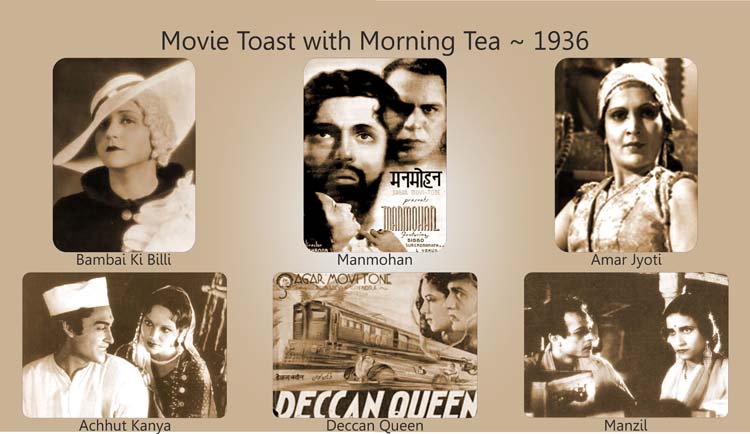
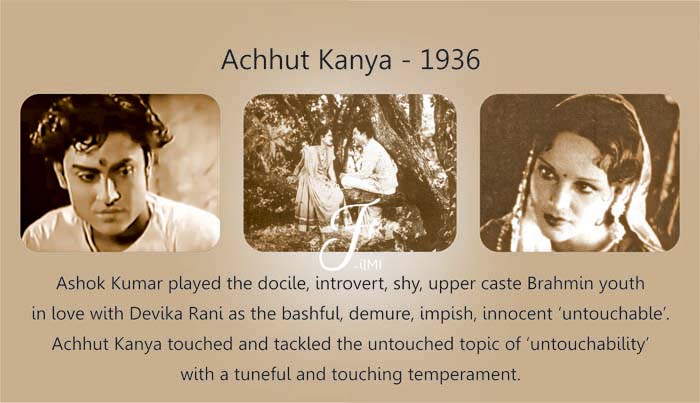
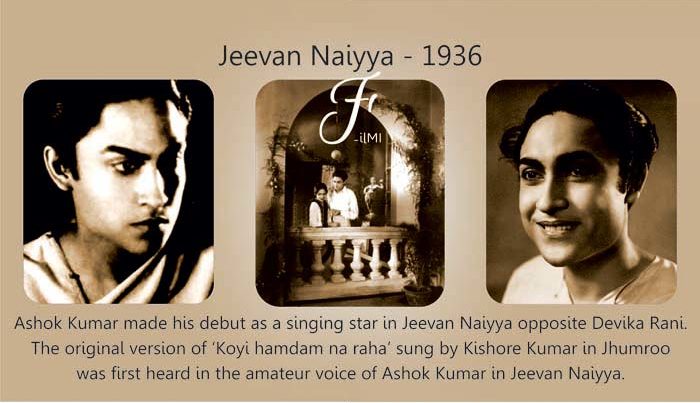
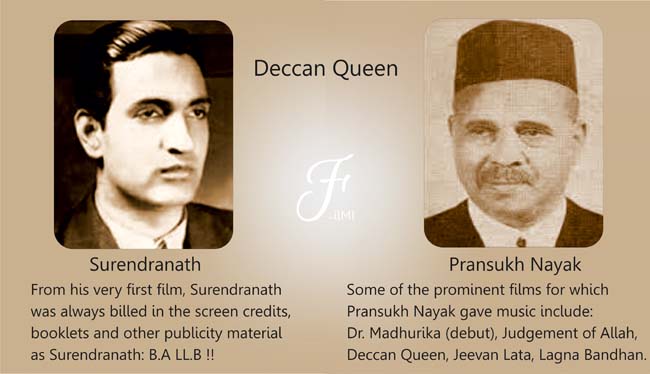
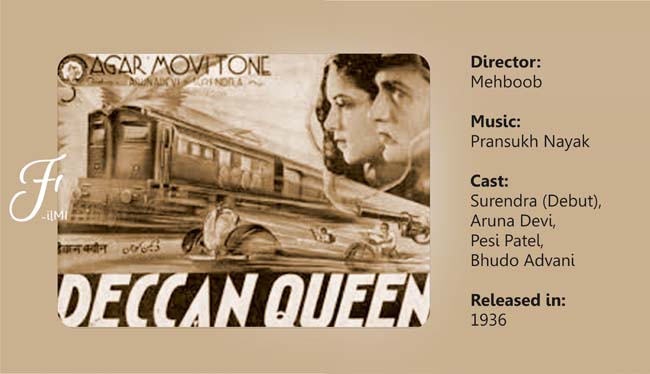
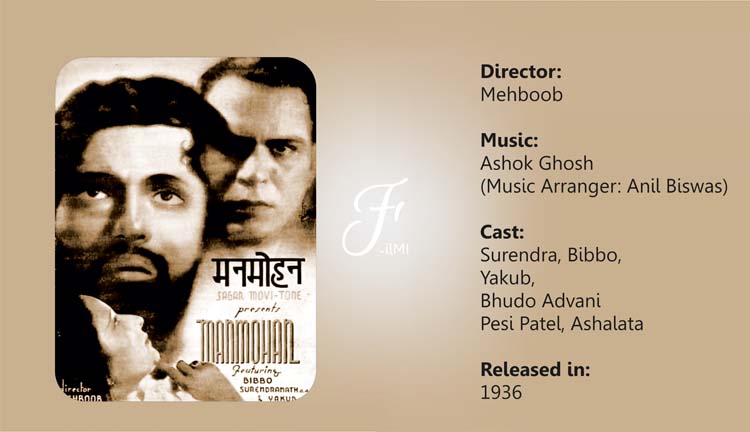
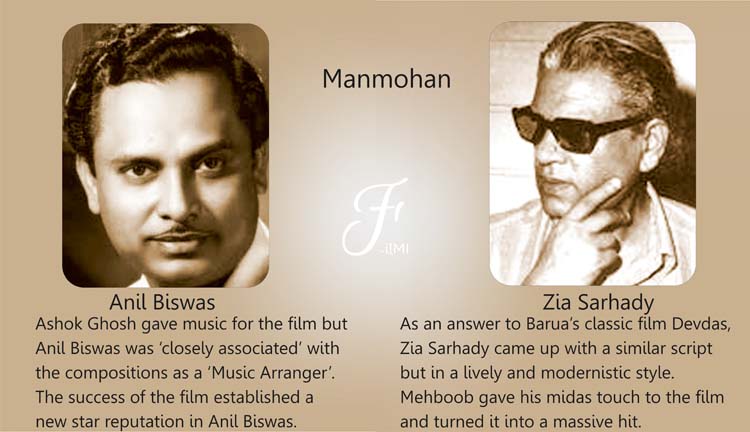
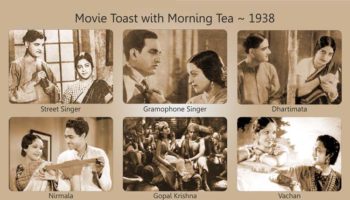
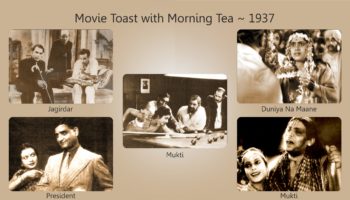
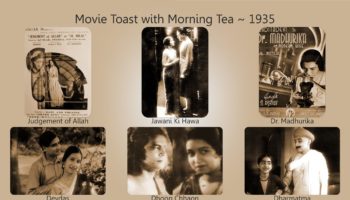
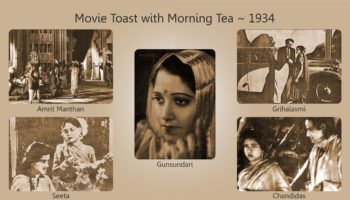

EXCELLENT, Very informative mind boggling details of the earliest times of Indian Film Industry.
Mr. Manohar Iyer’s name should be added to Legends if Hindi Film Industry, as the present and future generations would never know the details provided, without him.
Thank you very much Bharat Bhai. Manohar ko manohar hi rehne do koyi naam na do!!